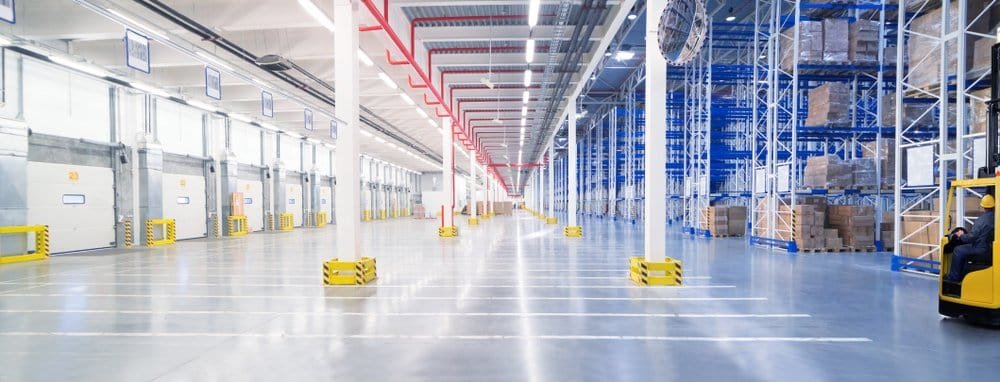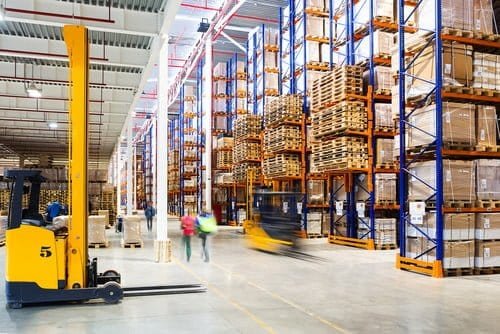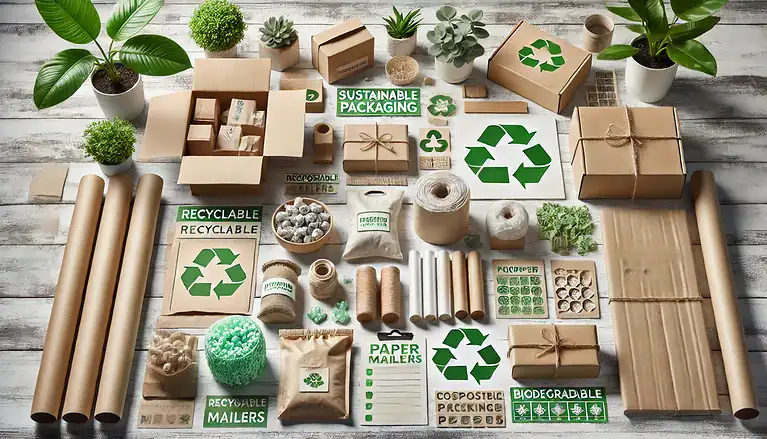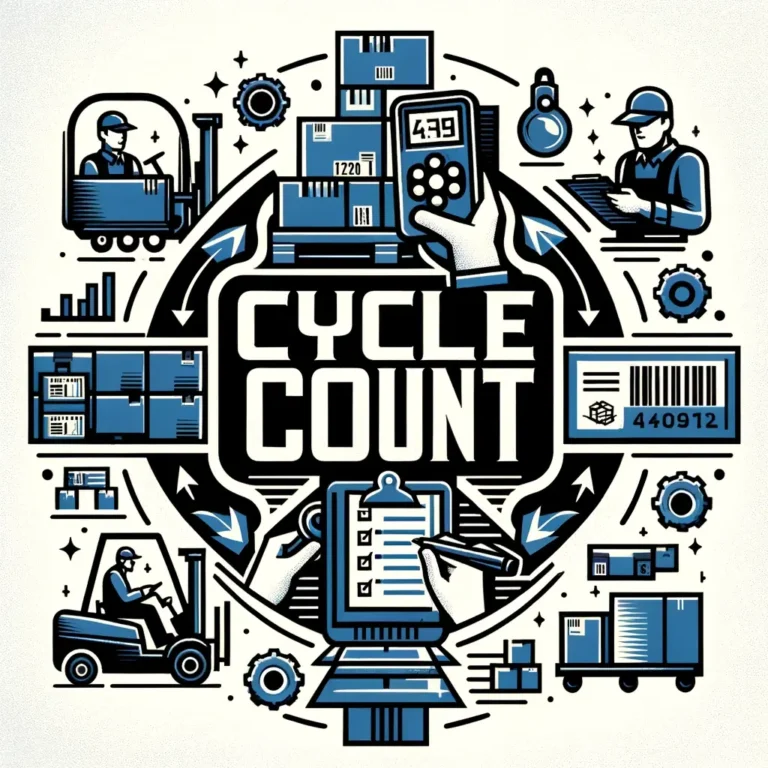Want a Lean Warehouse? Highly Effective Strategies for 2025
Imagine a warehouse where everything has its place, tasks flow smoothly, and products get picked and shipped with lightning speed. That’s the magic of creating a lean warehouse! No clutter. No waste. Just pick, pack, and ship!

Imagine a warehouse where chaos is replaced by calm efficiency. Pickers glide through aisles, effortlessly finding the items they need. Orders zip out the door, meeting deadlines consistently.
This isn’t a fantasy – it’s the reality of a lean warehouse. Lean warehousing applies lean manufacturing principles, originally developed by Toyota, to optimize warehouse operations.
By eliminating waste and streamlining processes, lean warehouses dramatically improve efficiency, cost reduction, and customer satisfaction.
In this blog post, we’ll explore the world of lean warehousing and equip you with the knowledge and tools to transform your own warehouse into a productivity powerhouse.
We’ll begin by exploring the core principles of lean warehousing, followed by a deep dive into the powerful 5S system, a cornerstone of lean practices. Get ready to unlock the full potential of your lean warehouse management skills!

The 5S System for Lean Warehouses
The 5S system is the bedrock of lean warehousing, providing a structured approach to creating a clean, organized, and efficient workspace. Each “S” represents a crucial step in the process:
Sort (Seiri)
Ruthlessly declutter your warehouse. Identify and remove unnecessary items – damaged equipment, obsolete inventory, and unused materials. A clean space translates to a clear mind for your pickers and minimizes wasted time searching for needed items.
Benefits of Sort
- Reduced clutter: A decluttered warehouse means less time wasted searching for needed items and less risk of tripping or bumping into obstacles.
- Increased space utilization: By removing unnecessary items, you free up valuable storage space that can be used for essential inventory.
- Improved inventory accuracy: Sorting eliminates the confusion of outdated or misplaced inventory, leading to more accurate stock counts.
- Enhanced safety: A clutter-free environment minimizes the risk of accidents or injuries.
Straighten (Seiton)
Establish a logical organization system. Assign designated storage locations for each item, considering factors like frequency of use and weight. This ensures pickers can quickly locate items, minimizing travel time and maximizing efficiency.
Benefits of Straighten
- Improved picking efficiency: With designated storage locations, pickers can quickly locate items, reducing travel time and increasing order fulfillment speed.
- Reduced picking errors: A clear organization system minimizes confusion and ensures pickers select the correct items.
- Simplified restocking: Designated storage locations make it easier to identify where items need to be restocked, streamlining the replenishment process.
- Enhanced workflow: A well-organized warehouse promotes a smoother flow of goods throughout the picking, packing, and shipping processes.
By combining these benefits, Sort and Straighten lays the groundwork for a lean warehouse by creating a clean, organized, and efficient workspace that allows your team to work smarter, not harder.
Shine (Seiso)
Maintain a clean and well-maintained warehouse:
- Develop cleaning schedules and procedures for equipment, walkways, and storage areas.
- Conduct regular inspections to identify potential issues like leaks, spills, or faulty equipment before they cause problems.
- Train employees on proper cleaning techniques to ensure they understand the importance of maintaining a clean environment.
Benefits of Shine
- Reduces downtime: Regular maintenance ensures equipment functions smoothly, minimizing the risk of breakdowns that disrupt operations.
- Enhances safety: A clean and clear workspace minimizes the risk of accidents and injuries.
- Improves product quality: A clean environment helps prevent damage to inventory, ensuring your customers receive products in pristine condition.
Standardize (Seiketsu)
The “Standardize” stage of the 5S system focuses on creating consistency and clarity in your warehouse operations. This ensures everyone is on the same page, leading to improved efficiency and reduced errors. Here’s how it works:
- Develop standardized work procedures: Document clear and concise instructions for all warehouse activities, including receiving, picking, packing, and shipping. These procedures should specify the steps involved, the tools needed, and the expected timeframe.
- Visualize the standards: Use visual aids like checklists, flowcharts, and floor markings to reinforce the standardized procedures. This will help employees understand and follow the steps, especially new hires.
- Maintain consistent organization: Ensure your storage layout, labeling system, and inventory management procedures are consistent throughout the warehouse. This eliminates confusion and streamlines picking and restocking processes.
Benefits of Standardize
- Reduces training time: Clear and documented procedures make training new employees easier and ensure everyone performs tasks consistently.
- Minimizes errors: Standardized procedures minimize the risk of mistakes during picking, packing, and shipping, improving order accuracy and customer satisfaction.
- Improves efficiency: Consistent practices allow for smooth workflow and minimize wasted time and effort due to confusion or inefficiencies.
Sustain (Shitsuke)
The final “S” in the 5S system, “Sustain,” is all about maintaining the progress you’ve made. Here’s how to ensure your lean practices become ingrained in your warehouse culture:
- Conduct regular audits: Schedule regular inspections to assess adherence to the established 5S standards. This helps identify areas for improvement and reinforces the importance of maintaining a lean environment.
- Promote continuous improvement: Encourage employees to identify opportunities to streamline processes further and eliminate waste. This fosters a culture of ownership and continuous improvement within the warehouse.
- Recognize and reward good practices: Acknowledge and reward employees who consistently demonstrate good 5S practices. This motivates everyone to maintain a clean, organized, and efficient workspace.
Benefits of Sustain
- Maintains a lean environment: Regular audits and continuous improvement efforts ensure your warehouse remains efficient and organized over the long term.
- Empowers employees: A culture of continuous improvement empowers employees to take ownership of their work environment and contribute to its ongoing success.
- Boosts morale: Recognition for good practices fosters a positive work environment and motivates employees to maintain high standards.
By effectively implementing the 5S system, you can transform your warehouse into a lean and efficient operation. In the next section, we’ll explore additional lean warehouse practices that build upon the foundation of the 5S system.
Implementing Lean Warehousing in Your Warehouse


Ready to transform your warehouse into a lean machine? Here’s a step-by-step guide to get you started:
1. Conduct a Warehouse Audit
- Begin by taking a comprehensive look at your current warehouse operations. Assess areas such as:
- Storage layout: Is it efficient and organized?
- Picking and packing processes: Are there bottlenecks or inefficiencies?
- Inventory management: Do you have accurate stock counts and control over inventory levels?
- Technology usage: Are you utilizing appropriate technology to streamline processes?
2. Develop a Lean Implementation Plan
- Based on your audit findings, create a plan outlining the specific lean practices you’ll implement. This plan should include:
- Goals and objectives: Set clear goals for what you want to achieve with lean warehousing (e.g., reduced picking times, improved inventory accuracy).
- Action steps: Outline specific actions you’ll take to implement lean practices (e.g., 5S system implementation, warehouse layout optimization).
- Timeline and resources: Allocate a timeframe for each action step and identify the resources needed (e.g., staff training, software).
3. Get Your Team Onboard


The success of lean warehousing hinges on employee buy-in.
- Communicate the benefits: Clearly explain how lean practices will benefit both the company and employees (e.g., improved efficiency, safer work environment).
- Provide training: Train your staff on the principles of lean warehousing and the specific procedures they’ll be following.
- Encourage participation: Involve your team in the process by encouraging suggestions for improvement and recognizing their contributions.
4. Implement and Monitor
Start rolling out your lean practices according to your plan.
- Prioritize: Focus on areas with the greatest potential for improvement.
- Track progress: Regularly measure key metrics to monitor your progress and identify areas for further optimization.
5. Continuous Improvement
Lean warehousing is an ongoing journey, not a destination.
- Regularly review and assess: Continuously evaluate your lean practices and identify opportunities for further improvement.
- Embrace adaptation: Be prepared to adapt your approach as your business needs and industry best practices evolve.
By following these steps and fostering a culture of continuous improvement, you can successfully implement lean warehousing in your warehouse and reap the rewards of increased efficiency, reduced costs, and enhanced customer satisfaction.
Additional Lean Warehouse Practices


The 5S system provides a solid foundation for lean warehousing, but it’s just the beginning. Here are some additional practices to further optimize your warehouse operations:
1. Warehouse Layout Optimization
- Analyze your current layout and flow of goods.
- Consider implementing a zone-picking strategy where frequently picked items are closer to the parking area.
- Utilize vertical space effectively with high-bay racking for less frequently accessed items.
- Implement a one-way traffic flow to minimize congestion and improve pickers’ efficiency.
2. Inventory Management Strategies
- Implement a robust inventory management system to track stock levels accurately and avoid stockouts or overstocking.
- Apply the ABC analysis to classify inventory based on value and frequency of use. Focus on optimizing storage and picking processes for high-value (A) and high-demand (B) items.
- Employ just-in-time (JIT) inventory principles when possible, minimizing storage requirements and reducing carrying costs.
3. Technology to Enhance Efficiency
- Leverage technology solutions like warehouse management systems (WMS) to streamline picking, packing, and shipping processes.
- Consider implementing automated storage and retrieval systems (AS/RS) for high-density storage and faster retrieval of goods.
- Explore using barcode scanners and mobile computers to improve picking accuracy and data collection.
4. Employee Training and Development
- Invest in ongoing training for your warehouse staff on lean practices, including proper equipment operation and safety procedures.
- Encourage cross-training to create flexibility and allow employees to cover different tasks when needed.
- Empower your team to identify and report inefficiencies, fostering a culture of continuous improvement.
By implementing these additional practices alongside the 5S system, you can create a truly lean and efficient warehouse operation. Remember, lean warehousing is an ongoing process.
Continuously evaluate your practices, embrace new technologies, and empower your team to contribute to a culture of improvement. The rewards of a lean warehouse – increased efficiency, reduced costs, and satisfied customers – are well worth the effort.
TIMWOODS: Eliminating Waste in Your Warehouse
The acronym TIMWOODS stands for eight types of waste that can hinder efficiency in any process. You can optimize your warehouse operations and achieve true lean principles by identifying and eliminating these wastes. Here’s how each waste applies to a lean warehouse:
T – Transport
This refers to unnecessary movement of materials within the warehouse. Lean practices aim to minimize transport by optimizing warehouse layout, implementing zone picking, and strategically placing frequently accessed items. In addition, you want to get your SKUs in their pick face right from the dock.
I – Inventory
Excessive inventory creates storage costs, increases the risk of obsolescence, and can mask underlying issues with forecasting or production planning. Lean warehouses focus on implementing just-in-time (JIT) inventory when possible.
Use an ABC analysis to prioritize storage and picking efficiency for high-value and high-demand items. The last thing you want to do is increase your travel around inventory that doesn’t move.
M – Motion
Unnecessary movement by pickers wastes time and energy. To minimize unnecessary motion, lean warehouses promote efficient picking routes, proper ergonomics, and well-organized storage layouts.
You also want to eliminate ‘dead’ travel on equipment with empty forks.
W – Waiting
Idle time for pickers or equipment waiting for materials or instructions translates to lost productivity. Lean principles involve optimizing workflows, improving communication, and having clear procedures to minimize waiting times.
This is where the theory of constraints knowledge is vastly important (chasing bottlenecks).
O – Overproduction
Moving more inventory than customer demand leads to storage costs and potential product damage. Lean warehouses emphasize production planning based on actual demand forecasts, helping to avoid over-staging.
O – Overprocessing
Performing unnecessary steps or using overly complex procedures in picking, packing, or shipping processes wastes time and resources. Lean practices aim to streamline workflows and eliminate unnecessary steps, focusing on value-adding activities.
One example is picking 13 units versus 1 case of 12 and 1 unit. There are tremendous savings from picking master cases.
D – Defects
Picking errors, damaged goods, or incorrect shipments create additional work and customer dissatisfaction. Lean principles involve implementing quality control measures, proper training, and clear procedures to minimize defects throughout the warehouse process. In addition, you must evaluate your shipping damages as well.
S – Skills Underutilization
Failing to utilize your workforce’s full potential is a waste of their skills and knowledge. Lean warehousing encourages employee training and development, promotes a culture of continuous improvement, and empowers staff to identify and address inefficiencies.
You can create a more efficient, cost-effective, and customer-centric warehouse operation by eliminating these wastes through lean practices. Remember, TIMWOODS is a constant reminder to identify and eliminate waste while pursuing a lean warehouse.


Conclusion
The journey to a lean warehouse is a path paved with continuous improvement. By implementing the strategies outlined in this blog post, you can transform your warehouse from a disorganized maze into a well-oiled machine of efficiency.
The 5S system provides a solid foundation, establishing a clean, organized, and standardized workspace. Building upon this, additional lean practices like optimized layout, strategic inventory management, and technology adoption further streamline operations.
Remember, your employees are key players in this journey. Train them on lean principles, empower them to identify inefficiencies, and foster a culture of continuous improvement.
By embracing lean warehousing, you’ll reap the rewards of:
- Increased Efficiency: Faster picking times, reduced errors, and smoother workflows improve operational efficiency.
- Reduced Costs: Minimized waste, optimized storage utilization, and lower labor costs contribute to significant cost savings.
- Enhanced Customer Satisfaction: Faster turnaround times, improved accuracy, and reduced damage ensure happy and loyal customers.
The path to lean warehousing may seem daunting, but taking it one step at a time will unlock a treasure trove of benefits for your business. Start implementing lean practices today and experience the transformative power of a truly optimized warehouse!







